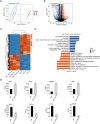Gene expression profiling of human umbilical vein endothelial cells overexpressing CELF2 as diagnostic targets in diabetes-induced erectile dysfunction
- PMID: 40692719
- PMCID: PMC12277130
- DOI: 10.3389/fmolb.2025.1596534
Gene expression profiling of human umbilical vein endothelial cells overexpressing CELF2 as diagnostic targets in diabetes-induced erectile dysfunction
Abstract
Background: Erectile dysfunction (ED) is a common complication of diabetes mellitus (DM), and because of its complex neurovascular etiology, the associated molecular pathogenic mechanisms are not fully understood. This study investigated the important functions and potential molecular regulatory roles of CELF2 in DMED.
Methods: An in vitro HUVEC model with CELF2 overexpression was successfully established via transfection with a CELF2-overexpressing lentiviral vector. The effects of CELF2 overexpression on cell proliferation and angiogenesis were assessed via CCK-8 and angiogenesis assays. RNA sequencing was employed to evaluate the gene expression profiles and alternative splicing events regulated by CELF2. An RNA-sequencing assay was performed to evaluate gene expression profiles and alternative splicing genes in HUVECs overexpressing CELF2, and an integration analysis was combined with GSE146078 data to detect potential target genes related to DMED.
Results: The expression of genes related to angiogenesis and the immune response significantly increased with CELF2 overexpression, and the four hub genes associated with alternative splicing in aging and angiogenesis were CXCL2, CXCL10, IL-1A and IL-6.
Conclusion: CELF2 appears to be a key factor in DMED, influencing gene expression and alternative splicing related to angiogenesis and immune responses. The identified hub genes (CXCL2, CXCL10, IL-1A, and IL-6) are closely related to DMED and warrant further investigation to understand the underlying mechanisms and potential therapeutic implications.
Keywords: CELF2; RBPs; RNA sequencing; diabetes mellitus; erectile dysfunction.
Copyright © 2025 Nuerdebieke, Yao, Guo, Li, Jia and Nan.
Conflict of interest statement
The authors declare that the research was conducted in the absence of any commercial or financial relationships that could be construed as a potential conflict of interest.
Figures





Similar articles
-
Exploring the Molecular Mechanisms and Biological Effects of CELF2 in the Development of Gastric Cancer.Recent Pat Anticancer Drug Discov. 2025 Aug 8. doi: 10.2174/0115748928387819250728053528. Online ahead of print. Recent Pat Anticancer Drug Discov. 2025. PMID: 40798961
-
Soluble Urokinase Plasminogen Activator Receptor (suPAR) as a Biomarker of Erectile Dysfunction in Diabetic Patients.J Clin Med. 2025 Jun 6;14(12):4029. doi: 10.3390/jcm14124029. J Clin Med. 2025. PMID: 40565774 Free PMC article.
-
CELF2 promotes tau exon 10 inclusion via hinge domain-mediated nuclear condensation.bioRxiv [Preprint]. 2024 Nov 3:2024.11.02.621395. doi: 10.1101/2024.11.02.621395. bioRxiv. 2024. PMID: 39553957 Free PMC article. Preprint.
-
Psychological and/or educational interventions for the prevention of depression in children and adolescents.Cochrane Database Syst Rev. 2004;(1):CD003380. doi: 10.1002/14651858.CD003380.pub2. Cochrane Database Syst Rev. 2004. Update in: Cochrane Database Syst Rev. 2011 Dec 07;(12):CD003380. doi: 10.1002/14651858.CD003380.pub3. PMID: 14974014 Updated.
-
The Black Book of Psychotropic Dosing and Monitoring.Psychopharmacol Bull. 2024 Jul 8;54(3):8-59. Psychopharmacol Bull. 2024. PMID: 38993656 Free PMC article. Review.
References
-
- Cannarella R., Condorelli R. A., Leanza C., Garofalo V., Aversa A., Papa G., et al. (2024). Dapagliflozin improves erectile dysfunction in patients with type 2 diabetes mellitus: an open-label, nonrandomized pilot study. Diabet. Med. a J. Br. Diabet. Assoc. 41 (1), e15217. 10.1111/dme.15217 - DOI - PubMed
LinkOut - more resources
Full Text Sources

